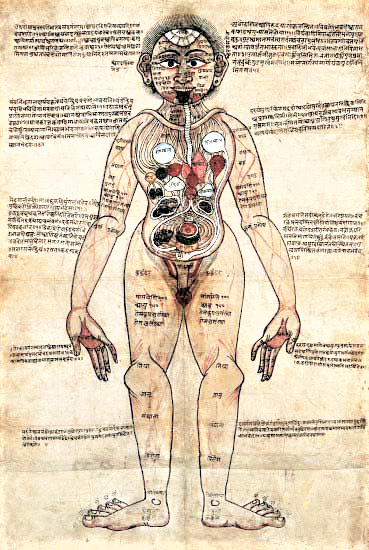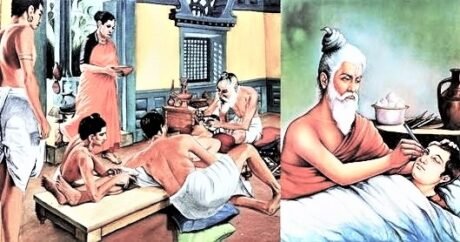
THE CONCEPT OF SURGERY IN VEDIC SAṂHITĀS
Article Credit : Dr. Priti Sinha
PART TWO : Types of Surgeries and Medical Fields
Synopsis: The second part of the series consists of Types of Surgeries practiced in Vedic times. It covers the human anatomy and details of surgeries like general surgery, obstetric and gynecological surgery, plastic surgery, transplant surgery and many more.
Surgery is the branch of medical practice that treats injuries, diseases, and deformities by the physical removal, repair, or readjustment of organs and tissues, often involving cutting into the body. In modern times there is General Surgery as well as Super Specialized fields in Surgery. To name few :
1. General surgery
2. Obstetric and Gynecological surgery
3. Ophthalmic surgery
4. Plastic surgery
5. Urological surgery
6. Transplant surgery
References to many of the above types of surgery is available in the scriptures, indicating the advanced level of knowledge during that time.
HUMAN BODY (Śarīr Vigyān)

A) Anatomy : Anatomy is the study of the physical structure and relationship between body parts. It organizes the body into several body parts or regions: upper limbs, lower limbs, trunk (thorax, abdomen, pelvis, back), head, and neck.
Names of various physical components like neck, muscle, bone, joints, shoulder, arms, intestine, anus, heart, viscera, liver, thigh, knee, heel, buttock, waist, rectum, pores (Lome, Chidraz) and nails etc. are found in hymns of tenth maṇḍala of Ṛgveda
grīvābhyasta uṣṇihābhyaḥ kīkasābhyo anūkyāt/
yakṣmaṃ doṣaṇyāmansābhyāṃ bāhubhyāṃ vi vṛhāmi te//
āntrebhyasta gudābho vaniṣṭhorhadayādadhi/
yakṣmaṃ matasnābhyā yakraḥ plāśibhyo vi vṛhāmi te//
urubhyāṃ te aṣṭhīvadbhyā pārṣṇibhyā prapadābhyām/
yakṣmaṃ śroṇibhyāṃ bhāsadādbhansaso vi vṛhāmi te//
mehanādvanaṃkaraṇāllomabhyoste nakhebhyaḥ/
yakṣaṃ sarvasmādātmanastamidaṃ vi vṛhāmi te//
aṅgādaṅgāllomnolomno jātaṃ parvaṇi parvaṇi/
yakṣmaṃ sarvasmādātmanastamidaṃ vi vṛhāmi te//
Ṛgveda 10.163.2-6
B) Physiology : Physiology is the study of the function of body parts and the body as a whole. It is a study of how organs work together to make things happen. Hymns explaining the physiology and its working in the human body are available in Yajurveda :
āntrāṇi sthālīrmadhu pinvamānā gudāḥ pātrāṇi sududhā na dhenuḥ/
śyenasya patraṃ na plīhā śacībhirāsandī nābhirūdaraṃ na mātā//
Yajurveda 19.86
It is very clear from the hymns that the seers during the Vedic age had a good knowledge about physiology. They also had in-depth knowledge about heart and other fatal spots (Marmasthala).
tiṣṭhāvare tiṣṭha para uta tvaṃ tiṣtha madhyame/
kaniṣṭhikā ca tiṣṭhati tiṣṭhādiddhamanirmahī//
Atharvaveda 1.17.2
“Oh arteries of the lower part of the body, oh arteries of the upper part of the body and oh the arteries of the middle part of the body! Let your bleeding stop. Let the bleeding of small arteries and the large arteries also stop.”
Reference of veins and arteries in Atharvaveda indicates a specialized knowledge of surgeons about physiology in context of surgery.
TYPES OF SURGERY & MEDICAL FIELDS IN ANCIENT TIMES
1) Plastic Surgery
Introduction : Plastic surgery is a surgical specialty involving the restoration, reconstruction, or alteration of the human body. It can be divided into two main categories: reconstructive surgery and cosmetic surgery.
Reconstructive surgery is defined as a surgical specialty dedicated to reconstruction of facial and body defects due to birth disorders, trauma, burns, and disease. Plastic surgery is intended to correct dysfunctional areas of the body and is reconstructive in nature.
Cosmetic surgery is a unique discipline of medicine focused on enhancing appearance through surgical and medical techniques. Cosmetic surgery can be performed on all areas of the head, neck and body. Because treated areas function properly but lack aesthetic appeal, cosmetic surgery is elective.
Scriptures : The description of removal of old age and restoration of youth to Cyavan, Kali and Ghoṣā is available in these hymns. The Aśvin brothers removed the wrinkles like an armor from the body of Cyavana and made him young again.
yuvaṃ cyavānamaśvinā jarantaṃ punaryuvānaṃ cakrathuḥ śacībhiḥ/
yuvo rathaṃ duhitā sūryasya saha śriyā nāsatyāvṛṇīta// –Ṛgveda 1.117.13
jujurūṣo nāsatyota vavriṃ prāmuñcataṃ drāpimiva cyavānāt/ –Ṛgveda 1.116.10
yuvaṃ viprasya jaraṇāmupeyuṣaḥ punaḥ kalerakṛṇutaṃ yuvadvayaḥ/ –Ṛgveda 10.39.8
ghoṣāyai cit pitṛṣade duroṇe patiṃ jūryantyā aśvināvadattam/ –Ṛgveda 1.117.7
amājuraścidbhavatho yuvaṃ bhago’Ѕnāśościdavitārāpāmasya cit/ –Ṛgveda 10.39.3
2) Arthrodesis Surgery
Introduction : Arthrodesis is also known as syndesis or artificial ankylosis. It is also commonly referred to as joint fusion. It is a method of surgical joint ossification used to fuse the bones in a joint when other treatments do not yield positive results.
Scriptures : The two Aśvin brothers successfully treated Śyāva whose body was cut into three pieces.
yadi kartam patitvā saṃśaśre yadi vāśmā prahṛto jaghāna/
ṛbhū rathasyevāṅgāni saṃdadhatparuṣā parūḥ//
Atharvaveda 4.12.7
If the wound is caused by spokes or pelted stones then the doctor puts broken bones together by matching the knuckles with other like a master artist (shilpī) repairs a broken chariot.
tridhā ha śyāvamaśvinā vikastamujjīvasa erayataṃ sudānū/
Ṛgveda 1.117.24
3) Ophthalmic Surgery (Eye)

Introduction : Eye surgery, also known as ocular surgery, is surgery performed on the eye or its adnexa, typically by an ophthalmologist. It is used to treat a variety of conditions, including cataracts, glaucoma, detached retinas, retinal tears, diabetic retinopathy and nearsightedness or farsightedness.
Scriptures : Discussion about restoration of eyesight of blind Ṛjāśva, Kaṇva and Parāvṛk by Aśvin brothers is available in the following hymns. All these discussions are available in the context of prayer or miraculous happenings showing that the eyesight was restored. Unfortunately, no specific surgical procedure is described.
ākṣī ṛjāśve aśvināvadhattaṃ jyotirandhāya cakrathurvicakṣe/ -Ṛgveda 1.117.17
yuvaṃ kaṇvāyāpiriptāya cakṣuḥ pratyadhattaṃ suṣtutiṃ jujuṣāṇā/ -Ṛgveda 1.118.7
yābhiḥ śacībhirvṛṣaṇā parāvṛjaṃ prāndhaṃ śroṇaṃ cakṣasa etave kṛthaḥ/ -Ṛgveda 1.112.8
4) Otoplasty (Ear)
Introduction : There are three main types of ear surgery to restore hearing :
- Stapedectomy — the replacement of a middle ear bone with a prosthesis
- Tympanoplasty — the reconstruction of the eardrum
- Myringotomy — the drainage of ear fluid to reduce infection and. Removal of ear tumors
Scriptures : The hymns praise The Aśvin brothers for donating hearing power to the son of Nṛṣada
pravācyaṃ tad vṛṣaṇā kṛtaṃ vāṃ yannārṣadāya śravo adhyadhattam/
Ṛgveda 1.117.8

5) Transplantation Surgery
Introduction : Transplant surgery is replacing dysfunctional organ by surgically transplanting an organ from a donor in order to improve, save or extend a patient’s life. It is a surgical specialty that performs organ transplants from live or deceased donors to recipients in need of a fully functioning organ. Organs that may be transplanted successfully include the heart, pancreas, liver, lungs and kidneys, among others. Single organs may be transplanted, or in more complex situations, multi-organ transplants can be performed.
Scriptures : The doctors of deities, Aśvin brothers transplanted the head of Dadhīci, son of sage Atharvā with the head of a horse.
ātharvaṇāyāśvinā dadhīce’śvyaṃ śiraḥ pratyairayatam/
sa vāṃ madhu pra vocadṛtāyan tvāṣṭraṃ yad dasrāvapikakṣyaṃ vām/
Ṛgveda 1.117.22
6) Prosthesis
Introduction : A prosthesis or prosthetic implant is an artificial device that replaces a missing body part, which may be lost through trauma, disease, or a condition present at birth. Prostheses are intended to restore the normal functions of the missing body part.
Scriptures : The Aśvin brothers made Viśpalā, the wife of king Khela capable of moving by transplanting the broken thigh with an artificial iron-made thigh.
caritraṃ hi verivācchedi parṇamājā khelasya paritakmyāyām/
sadyo jaṅghāmāyasīm viśpalāyai dhane hite sartave pratyadhattam//
Ṛgveda 1.116.15
7) Obstetrics
Obstetrics is the branch of medicine related to medical and surgical care before, during, and after a woman gives birth. Obstetrics focuses on caring for and maintaining a woman’s overall health during maternity.
A) Normal Labor :
In 1997, the World Health Organization defined normal birth as “spontaneous in onset, low-risk at the start of labor and remaining so throughout labor and delivery. The infant is born spontaneously in the vertex position between 37 and 42 completed weeks of pregnancy.
Pleased with the prayer of Vadhrimatī, the Aśvin brothers removed labor pain and facilitated her with an excellent son (Suṣutim).
yuvaṃ havaṃ vadhrimatyā agacchataṃ yuvaṃ suṣutiṃ cakrathuḥ purandhaye/
Ṛgveda 10.39.7
B) Obstructed Labor :
Obstructed labor, also known as labor dystocia, is when the baby does not exit the pelvis during childbirth due to being physically blocked, despite the uterus contracting normally. Complications for the baby include not getting enough oxygen which may result in death.
(i) Episiotomy (Vaginal Incision) :
An episiotomy is an incision made in the perineum — the tissue between the vaginal opening and the anus — during childbirth.
In case of obstructed labor vaginal incision and cutting adjacent structures around were done to save the child of obstructed fetus in the Vedic age.
vi te bhinadmi mehanam vi yoniṃ vi gavīnike/
Atharvaveda 1.11.5
(ii) Caesarean Section :
Caesarean section, also known as C-section, or caesarean delivery, is the surgical procedure by which a baby is delivered through an incision in the mother’s abdomen, often performed because vaginal delivery would put the baby or mother at risk.
vi mātaraṃ ca putraṃ ca vi kumāraṃ jarāyuṇāva jarāyu padyatām/
Atharvaveda 1.11.5
8) Gynecology
Introduction : Gynecology is the medical practice dealing with the health of the female reproductive system (vagina, uterus, and ovaries). Its counterpart is andrology, which deals with medical issues specific to the male reproductive system.
Scriptures : Use of fire and other means to treat the diseases related to uterus and vagina is recommended in Vedic Sanhitās.
brahmaṇāgniḥ saṃvidāno rakṣohā bādhatāmitaḥ/
amīvā yaste garbha durṇāmā yonimāśaye//
Ṛgveda 10.162.1
9) Urology Surgery

Introduction : Urology surgery is the integration of surgical activities for the pelvis-the colon, urogenital, and gynecological organs-primarily for the treatment of obstructions, dysfunction, malignancies, and inflammatory diseases.
Various methods of urology surgery are available in Vedic Sanhitās.
10) Lithotomy
Introduction : Lithotomy is a surgical method for removal of calculi, stones formed inside certain organs, such as the urinary tract (kidney stones), bladder (bladder stones), and gallbladder (gallstones), that cannot exit naturally through the urinary system or biliary tract. The procedure is usually performed by means of a surgical incision (therefore invasive).
Scriptures :
pra te bhinadmi mehanaṃ vartram veśantyā iva/
evā te mūtraṃ mucyatāṃ bahirbāliti sarvakam//
viṣitaṃ te vastibilaṃ samudrasyodadheriva/
evā te mutraṃ mucyatāṃ vahirbāliti sarvakam//
Atharvaveda 1.3.7-8
11) Urinary Retention
Introduction : Urinary retention is a condition in which one cannot empty all the urine from the bladder. Urinary retention can be acute, sudden inability to urinate, or chronic, a gradual inability to completely empty the bladder of urine.
Scriptures :
yadāntreṣu gavīnyoryadvastāvadhi saṃśrutam/
evā te mūtraṃ mucyatāṃ bahirbāliti sarvakam//
Atharvaveda 1.3.1
In case of an obstruction in urinary track, an arrow or iron rod was used for removal of the obstruction.
yatheṣukā parāpatadavasṛṣṭā’Ѕdhi dhanvanaḥ/
evā te mūtraṃ mucyatāṃ bahirbāliti sarvakaṃ//
Atharvaveda 1.3.9
12) Control of Hemorrhage
Introduction : Hemorrhage is the release of blood from a broken blood vessel, either inside or outside the body. The most important thing regarding hemorrhage control is to stop the bleeding, using the simplest methods as soon as possible to prevent shock and the worsening of shock. Direct pressure and pressure dressings are the most common and effective tools in preventing extremity hemorrhage.
Scriptures :
amūryā yanti yoṣito hirā lohitavāsasaḥ/
abhrātara iva jāmayastiṣṭhantu hatavarcasaḥ//
Atharvaveda 1.17.1
These blood circulating vessels which are bleeding due to wounds should become speed-less stops the same way as the brother-less sisters stay in their ancestral family for the lifetime.
śatasya dhamanīnāṃ sahasrasya hirāṇām/
asthurinmadhyamā imaḥ sākamantā araṃsata//
Atharvaveda 1.17.3
13) Care of wounds

Introduction : Wounds are injuries that break the skin or other body tissues. They include cuts, scrapes, scratches, and punctured skin. They often happen because of an accident, but surgery, sutures, and stitches also cause wounds. Minor wounds usually aren’t serious, but it is important to clean them.
Scriptures : Several hymns are available in Atharvaveda to treat wounds. The description of medicines, liniments and plasters to be used to treat the wounds caused by arms and bone fractures are available in these Sanhitās. Description of putting together of marrows, skins and pores (lomes & chidra) as means of treating the wounds are described in a hymn.
majja majjña saṃghīyatāṃ carmaṇā carma rohatu/
asṛkte asthi rohatu mānsaṃ mānsena rohatu//
loma lomnā saṃ kalpayā tvacā saṃ kalpayā tvacam/
asṛkte asthi rohatu cchinnaṃ saṃdhehyoṣadhe//
Atharvaveda 4.12.4-5
14) Vasectomy
Introduction : Vasectomy is a form of male birth control that cuts the supply of sperm to the semen. It’s done by cutting and sealing the tubes that carry sperm.
Scriptures : As per the above hymn, Indra turned a male into a female by medicine and long hair on his sculp. May Indra break the two testicles of a man apart with two stones.
klībaṃ krdhyopaśinamatho kurīriṇaṃ kṛdhi/
athāsyendro grāvabhyāmubhe bhinattvāṇḍyau//
Atharvaveda 6.138.2
Description about incision of two sperm/semen cords with the help of arm named Śamyā is available in another hymn in this context.
ye te nādyau’Ѕdevakṛte yayostiṣṭhati vṛṇyam/
te te bhinadmi śamyayāmuṣyā adhi muṣkayoḥ//
Atharvaveda 6.138.4
15) Resuscitation
Introduction : Resuscitation is the act or an instance of reviving someone from apparent death or from unconsciousness. It is the process of correcting physiological disorders (such as lack of breathing or heartbeat) in an acutely ill patient. Few examples of Resuscitation are cardiopulmonary resuscitation and mouth-to-mouth resuscitation.
Scriptures : “Oh Aśvin brothers, the facilitator of desideratum! You have resuscitated Rebha who was kept almost dead in a cave.”
yuvaṃ ha rebhaṃ vṛṣaṇā guhā hitamudairayataṃ mamṛvāṃsamaśvinā/
Ṛgveda 10.39.9
In Vedic age, human life was more integrated with nature. Their life style was more balanced and aligned. They were sincere in austerity with good meditative and other scientific practises for their body and soul. In comparison to current times, there was far less environmental and chemical pollution.
In modern times, we face a lot of diseases which seem to be an off shoot of our lifestyle choices, pollution, stress, food choices and so on. With the advent of new branches of medicine, like Robotic Surgery, Microscopic Surgery, Endoscopic Surgery etc. we are progressing very strongly in the medical field.
Continued in Part Three : Surgery in Samhitās
The ancient times might not have as advanced and sophisticated equipment’s as now, but we can still learn a lot from them. Their co-existence with the rest of the nature and environment was far more cohesive. It is also reflected in their medical treatments. Knowledge is power and it is limitless !!
Disclaimer : The practices and methods elaborated in the articles are not in any way suggestive to be used by or on anyone. It is just a source of information strictly for knowledge purposes only.
- RELATED ARTICLES
- Surgery in Ancient India: Introduction (Part One)
- Surgery in Ancient India: Surgery in Samhitās (Part Three)
- Scientific Analysis of the birth of Kauravas
- Ancient Remedies for Anxiety and Depression
- Aeronautics in Ancient India (PART 1)
- Knowledge of Mathematical Value of Π (PI)

